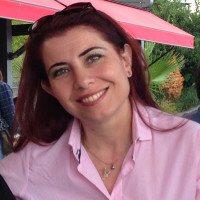Research Article
Issue Editorial Board

...





Prof. Dr. Saadet KARAKULAK, Head of the Fisheries Faculty-Department of Fisheries Technology. Aquaculture Engineer (Bachelor), Masters and PhD. degrees in Fisheries Biology. Main areas of research are; Fish Population Dynamic, Age and growth analysis, Reproduction, Stomach content, Fishing Gear Technology and High Migratory Species Fishery. Published over 100 papers and eight books. He has many projects on fisheries biology and population dynamic safety and also he has been working at Istanbul University, Faculty of Aquatic Sciences for 30 years and is working actively in EU project REPRODOTT (Q5RS-2002-01355) as subcontractor and a pilot study of the monitoring of the bluefin tuna in the eastern Mediterranean, Italian Ministry of Agriculture and Forestry (Reg.1543/00 and Reg. 1639/01). She has been participating in the ICCAT scientific committee since 2003.









 Web
Web


He completed his undergraduate studies in the Fisheries Technology Engineering Program at Karadeniz Technical University, Sürmene Faculty of Marine Sciences; his master’s degree in the Department of Fisheries Technology Engineering; and his Ph.D. in the Aquaculture Department of the Graduate School of Natural and Applied Sciences at Ege University. He received the titles of Research Assistant in 1996, Assistant Professor in 2002, Associate Professor in 2011, and Professor in 2016. He is currently serving as a faculty member in the Department of Aquaculture, Division of Aquaculture, at Muğla Sıtkı Koçman University, Faculty of Fisheries. His areas of expertise include aquaculture, fish nutrition, feed technology, alternative feed ingredients, organic fish farming, and fisheries economics.




Ahmet Mutlu GÖZLER carried out research for a PhD on the reproduction biology on bivalves. His work includes both the effects of ecological factors on living things and invertebrates. Specialization: (i) Main area Marine Biology. He conducts studies on the distribution of marine invertebrates and the determination of the ecological quality of the seas. (ii) Current research areas invertebrates in the Black Sea and Marine pollution (iii) marine litter and microplastics






 Web
Web






 Web
Web
Born in 1966 in the Torul district of Gümüşhane province, Coşkun ERÜZ completed his primary and secondary education in Trabzon. He began his undergraduate studies at the KTÜ Marine Science Faculty Fisheries Technology and Technology in 1984 and graduated with a Fisheries Technology Engineer title in 1988. He completed his master's degree at the Institute of Science at the same university in 1992. He completed his doctorate at the same institute in 1999 and received his doctorate. He was appointed to the Sürmene School of Marine Sciences and Technology as a Research Assistant in 1991 and began working as an Assistant Professor in the same department in 1999. He began working in the Department of Marine Sciences and Technology Engineering in 2023, becoming an Associate Professor in 2019 and a Professor in 2022. He continues to work in the same department. In addition to his administrative roles as department vice chair and vice dean, he has served on numerous administrative committees, faculty boards, and administrative boards. His teaching, research, and publications focus on physical oceanography, marine pollution, coastal areas, coastal structures and management, and marine meteorology.




I am an Associate Professor at the Faculty of Fisheries, Department of Fishing Tecnology Recep Tayyip Erdogan University in TURKEY. I have extensive field and laboratory experience (more than 25 years) in feeding eco-physiology of fish and jellyfish (especially exotic species), fisheries biology . Particular expertise on macrozooplankton feeding physiology experiments and gastric emptying time and rate as well as feeding ecology in fishes.



Aim & Scope
This Journal publishes studies on Maritime and Marine Sciences subjects.
Our Journal covers various topics of marine technology production and development such as; aquatic ecosystems and populations, marine pollution, fisheries, aquaculture, genetics and biotechnology studies, geological, biological, physical and chemical oceanography studies, naval architecture and marine engineering subjects, offshore systems, underwater and coastal structures, renewable energy generation together with maritime transportation, maritime management and logistics, underwater archaeology and maritime history subjects.
Author Guidelines
Page layout
A4 paper size should be used for the submissions with left, right, bottom margins of 2 cm and a top margin of 3 cm. The text should be both left and right justified and the vertical spacing should be 1 lines with no blank lines between paragraphs. Times New Roman fonts should be used in the whole document with a font size of 12 points.
Title of the Article
Title should be short, explanatory and the first letter of title should be written in capital letters the rest should be written in lowercase letters (12 points) with center alignment. If the language of the article is Turkish, Turkish title and the abstract should be written first and then followed by the English title and the abstract.
Authors
Initial(s) of the author(s)’s first name(s) should be written with capital letters and the rest should be written in lowercase letters, surname(s) should be written in capital letters. Author(s)’s name(s) should be written with center aligned text (12 points). Superscripted numbers (1, 2 ...) should be used following the author(s)'s name(s) to indicate the address(es). The responsible author should be indicated by an additional superscripted star symbol (*) following his/her name. Full address(es) of the author(s) should be written just below the author(s)’s name(s) in lowercase letters (10 points, center aligned), the responsible author's e-mail address should be footnoted (10 points). Author(s)’s name(s) should not include any academic titles. Turkish and English abstracts should be between 150 and 250 words.
Abstract and Keywords
Turkish and English abstracts should be between 150 and 250 words.
Keywords: Sample keyword 1, Sample keyword 2, Sample keyword 3, Sample keyword 4, … (Between 4 and 6 keywords should be given below the abstract. First letter of keywords must be written with capital and the others must be written in lowercase (12 points). Repetition of the title should be avoided in the keywords).
Section Titles
The main section titles in the text should be written in Times New Roman format, 12 point font, bold, with the title in all capital letters, aligned left, and numbered starting from the Introduction section. Subsection titles should be written in 12-point Times New Roman format, with only the first letters of the title words capitalized. There should be a space of 6 nk between the headers of the sub-sections. Decimal numbers should be separated by a dot, and there should be no comma in the thousands separator. For example, 45.2, 2036.4, 1598456.8 etc.
References to be cited in the text should be indicated as "(Author(s), Year) or Author(s), (Year)". In references with two or more authors, it should be used as (Author et al., Year). For example, Cihat et al., (2015) (Ahmet et al., 2020). When listing references, they should be done in alphabetical order.
The article should be composed of Abstract, Introduction, Material and Methods, Results, Discussions and Conclusions main sections followed by References part (and additional Recommendations and Acknowledgements sections if necessary).
Representations such as photographs, pictures, drawings and graphics other than the table should be given as "Figures". Figures must be clear and suitable for offset printing technique. The minimum resolution of figures must be 300 dpi. The location of each table and figure in the text should be stated. All tables and figures should be numbered sequentially throughout the study (Table 1., Figure 1.). Figure and Table headers should be written in 12-points. The text in the table should be written as 10 points. Graphs and figures should be drawn taking into account page dimensions. Examples of the layout of figures and tables are as follows.
Sequence numbers and titles of figures should be written below the figure, and those of tables should be written above the table.
References
- Unpublished works such as; researches under preparation or submitted for publication, unpublished results or observations, information via personal communication, reports, lecture notes and seminars should not be referenced. An unpublished but printed thesis study can be used a reference.
- References part should have single line spacing and should be written in 10 points fonts.
Citation
References should be cited between “ ( ) ” in the text. Enumeration should follow the citation order an alphabetical sort.
a) Article:
Examples:
Abbey, L., Glover-Amengor, M., Atikpo, M.O., Atter, A., Toppe, J. (2017). Nutrient content of fish powder from low value fish and fish byproducts. Food Science and Nutrition 5(3): 374-379. doi:10.1002/fsn3.402.
Amaral, A.F.S. (2014). Pesticides and Asthma:Challenges for Epidemiology. Front Public Health 2(6): 1-3. doi: 10.3389/fpubh.2014.00006.
Chen, J., Bian, W., Wan, Z., Yang, Z., Zheng, H., Wang, P. (2019). Identifying factors influencing total-loss marine accidents in the world: Analysis and evaluation based on ship types and sea regions. Ocean Engineering 191: 106495.
Di Pierro, G., O’Keeffe, M.B., Poyarkov, A., Lomolino, G., Richard, J., Gerald, F. (2014). Antioxidant activity of bovine casein hydrolysates produced by Ficus carica L.-derived proteinase. Food Chemistry 156: 305-311. doi:10.1016/j.foodchem.2014.01.080.
Haq, A., Webb, N.B., Whitfield, J.K., Howell, A.J., Barbour, B.C. (1973). Measurement of Sausage Emulsion Stability by Electrical Resistance. J. Food Sci. 38: 1124- 1127.
Khiari, Z., Rico, D., Martin-Diana, A.B., Barry-Ryan, C. (2015). Valorization of fish by-products: rheological, textural and microstructural properties of mackerel skin gelatins. Journal of Material Cycles and Waste Management 19(1): 180-191. doi: 10.1007/s10163-015-0399-2.
Lalasidis, G., Bostrom, S., Sjoberg, L.B. (1978). Low molecular weight enzymatic fish protein hydrolysates: Chemical composition and nutritive value. Journal of Agricultural and Food Chemistry 26(3): 751-756.
Teng, M., Zhang, H., Fu, Q., Lu, X., Chen, J., Wei, F. (2013). Irrigation-induced pollution of organochlorine pesticides and polychlorinated biphenyls in paddy field ecosystem of Liaohe River Plain, China. Chinese Science Bulletin 58: 1751-1759. doi: 10.1007/s11434-013-5815-1.
Tsaboula, A., Papadakis, E.N., Vryzas, Z., Kotopoulou, A., Kinyzikoglou, K., Papadopoulou-Mourkidou, E. (2019). Assessment and management of pesticide pollution at a river basin level part I: Aquatic ecotoxicological quality indices. Science of The Total Environment 653: 1597-1611. doi: 10.1016/j.scitotenv.2018.08.240.
Wang, H., Liu, Z., Wang, X., Graham, T., Wang, J. (2021). An analysis of factors affecting the severity of marine accidents. Reliability Engineering & System Safety 210: 107513.
Zhang, S., Pedersen, P.T., Villavicencio, R. (2019). Probability of ship collision and grounding. Probability and Mechanics of Ship Collision and Grounding 1–61. doi:10.1016/b978-0-12-815022-1.00001-3.
Zhang, Y., Sun, X., Chen, J., Cheng, C. (2021). Spatial patterns and characteristics of global maritime accidents. Reliability Engineering & System Safety 206: 107310.
Maden, S. (2006). Diferansiyel Denklemler, Birinci baskı, s. 358, Ankara, Sözkesen Matbaacılık.
Gökalp, H.Y., Kaya, M., Zorba, Ö. (1999). Et Ürünleri İşleme Mühendisliği, 3. Baskı, Erzurum, Atatürk Üniversitesi Yayın No: 786.
Uğur, M.B., Bostan, K., Aksu H. (1998). Et ve Et Ürünleri Teknolojisi Ders Notları, İstanbul, İstanbul Üniversitesi Veteriner Fakültesi Yayını.
Kence, A., Bilgin C.C. (1996). Türkiye Omurgalılar Tür Listesi, s. 183, Ankara, Nurol Matbaacılık.
Polat, N., Uğurlu, S. (2011). Samsun İli Tatlı Su Balık Faunası, s. 288, Samsun, Ceylan Ofset.
c) Book Section:
Examples:
Nelson D.W., Sommers, L.E. (1982). Organic Matter. In: “Methods of Soil Analysis Part 2. Chemical and Microbiological Properties 2nd Ed.” (Editors: A.L. Page, R.H, Miller, D.R. Keeney), Agronomy. No: 9, pp. 574-579, Madison, Wisconsin.
Varnam, A.H., Sutherland, J.P. (1995). Fermented sausages. In: “Meat and Meat Products: Technology, Chemistry and Microbiology”, Chapman & Hall, pp. 314-344, London.
Sgarbieri, V.C. (1987). Alimentaçäo e nutriçäo: fator de saúde e desenvolvimento. In: “Alimentaçäo e nutriçäo: fator de saúde e desenvolvimento”, pp. 387-387.
d) Conference/Symposium Proceedings:
Examples:
Balık, İ., Çubuk, H. (2001). Uluabat (Apolyont) Gölü ndeki kızılgöz (Rutilus L. 1758) ve tahta balığı (Blicca björkna L., 1758) populasyonlarının büyüklük dağılımları ve kondisyon faktörleri, XI. Ulusal Su Ürünleri Sempozyumu, Cilt I, 384-392, Hatay.
Yeğen, V., Balık, S., Bostan, H., Uysal, R., Bilçen, E. (2006). Göller Bölgesi’ndeki Bazı Göl ve Baraj Göllerinin Balık Faunalarının Son Durumu. 1. Ulusal Balıklandırma ve Rezervuar Yönetimi Sempozyumu, 7-9 Şubat 2006, s. 129-139, Antalya.
Arpa, H. (2003). Su Ürünleri Sektöründe Kamu Örgütlenmesi. AB’ne Üyelik Sürecinde Su Ürünleri Sempozyumu, 16 Ekim 2003, s. 54-59, Ankara.
e) Web Page:
If the author of the web page is known:
Example:
European Maritime Safety Agency (EMSA), Preliminary Annual Overview of Marine Casualties and Incidents 2014-2019 reports (2020). Accessed Date: 17.04.2021, http://www.emsa.europa.eu/emsa documents/latest/tagged/85-annual-overview.html is retrieved.
Formal Software Construction (FSC), Open FTA Manual Version 1.0. (2005). Accessed Date: 08.08.2021, https://www.scribd.com/document/244727771/Open-FTA is retrieved.
International Maritime Organization (IMO), Maritime Safety (2019). Accessed Date: 12.03.2021, http://www.imo.org/en/OurWork/Safety/Pages/Default.aspx is retrieved.
Japan Transport Safety Board (JTSB), Marine accident database (2020). Accessed Date: 03.04.2021, https://www.mlit.go.jp/jtsb/statistics_mar.html is retrieved.
Marine Accident Investigation Branch (MAIB), Investigations reports and safety bulletins (2021). Accessed Date: 07.08.2021, https://www.gov.uk/government/organisations/marine-accident-investigation-branch is retrieved.
United Nations Conference on Trade and Development (UNCTAD), Review of Maritime Transport (2019). Accessed Date: 12.02.2021, https://unctad.org/system/files/official-document/rmt2019_en.pdf is retrieved.
If the author of the web page is unknown:
Example:
URL-1, Ship Form: Kriso Container Ship (KCS) (2015). Accessed Date: 21.06.2015, https://www.nmri.go.jp/institutes/fluid_performanc e_evaluation/cfd_rd/cfdws05/Detail/KCS/kcs_g&c.html
f) Thesis:
Examples:
Dumay, J. (2006). Extraction de lipides en voie aqueuse par bioréacteur enzymatique combiné à l'ultrafiltration: application à la valorisation de co-produits de poisson (Sardina pilchardus). Ph.D. Thesis, Université de Nantes.
Karakaya, M. (1990). Assessment of the attributes of meat emulsion of various species with oil and fat in a model system (in Turkish), PhD. Thesis, Ataturk University, Institute of Natural and Applied Sciences, 60 p., Erzurum.
Koç, S. (2016). Hamsi (Engraulis encrasicolus) ve İşleme Atıklarından Elde Edilen Protein Hidrolizatlarının Besleyici, Fonksiyonel Ve Biyoaktif Özelliklerinin Araştırılması, Doktora Tezi, Çanakkale On Sekiz Mart Üniversitesi Fen Bilimleri Enstitüsü, Çanakkale.
Korkmaz, K. (2018). Ticari Enzimler Kullanılarak Farklı Balık Türü Atıklarından Hidrolizat Üretimi ve Kalitesinin Belirlenmesi. Doktora Tezi, Ordu Üniversitesi Fen Bilimleri Enstitüsü, Ordu.
g) Official Gazette:
Examples:
Resmi Gazete, (1991). Tarım ve Köyişleri Bakanlığının Kuruluş ve Görevleri Hakkında Kanun Hükmünde Kararname, 9.08.1991 tarih 20955 sayılı Resmi Gazete.
Official Gazette, (2011). Gıda, Tarım ve Hayvancılık Bakanlığının Teşkilat ve Görevleri Hakkında 3.06.2011 Tarih ve 639 Sayılı Kanun Hükmünde Kararname, 8/6/2011 tarih ve 27958 mükerrer sayılı Resmi Gazete.
h) Patents:
Examples:
Kitchen, 1986. “Combustion Improver Fuel Additive”. US Patent No: 4, 585, 462.
i) Footnotes: Only on the first page, the e-mail address of the responsible author and, if submitted, part of the work, thesis or project work should be specified as a footnotes.
j) Reports:
Examples:
Ercoşkun, H. (2000). Turkiye Fisheries Report. Country Report, Handling and Primary Processing of Marine Products Jica Kanagawa International Fisheries Training Center, May 29th.
Hino, T. (2005). Proceedings of CFD Workshop Tokyo 2005. NMRI Report 2005, Tokyo, Japan.
ITTC (2014). Resistance Committee Report. Proceedings of 27thInternational Towing Tank Conference.
DPT (2001). Sekizinci Beş Yıllık Kalkınma Planı. Su ürünleri ve su ürünleri sanayii özel ihtisas komisyon raporu. DPT Yayın No. 2575, Ankara.
k) Technical Notes:
Examples:
Tamura, M., Inoue, H., Watanabe, T., Maruko, N. (2001). Research on a brake assist system with a preview function. In: SAE technical paper 2001-01-0357, Society of Automotive Engineers 2001 World Congress, Detroit, MI, USA.
Murray, J., Burt, J.R. (2001). The Composition of Fish. Ministry of Technology, Torry Research Station, Torry Advisory Note No. 38.
FAO (2008). Understanding and applying risk analysis in aquaculture. (Editors: G. Melba, M.G. Bondad-Reantaso, J.R. Arthur, R.P. Subasinghe), FAO Fisheries and Technical Paper. No. 519, Rome, 324 pp.
l) Publications that can be guides/procedures:
Examples:
ITTC (2002). Uncertainty Analysis, Example for Resistance Test, ITTC Recommended Procedures and Guidelines, Procedure7.5-02-02-02, Revision 01.
ITTC (2002b). Resistance Test, ITTC Recommended Procedures and Guidelines, Procedure7.5-02-02-01, Revision 01.
Soto, Y.A. (2006). Proitability analysis of the investment in beam trawlers for cuban shrimp fisheries, The United Nations University Fisheries Training Programme, Final Project, Cuba.
m) Appendixes: All appendixes should be written on separate pages and numbered with Roman numerals.
AUTHORSHIP CONTRIBUTION STATEMENT
Author 1: (Author First and Last Names must be written!!!) Conceptualization, Methodology, Validation, Formal Analysis, Resources, Writing - Original Draft, Writing-Review and Editing, Data Curation, Software, Visualization, Supervision, Project administration, Funding acquisition. Author 2: (Author First and Last Names must be written!!!) Conceptualization, Methodology, Validation, Formal Analysis, Resources, Writing - Original Draft, Writing-Review and Editing, Data Curation, Software, Visualization, Supervision, Project administration, Funding acquisition. Author n: (Author First and Last Names must be written!!!) Conceptualization, Methodology, Validation, Formal Analysis, Resources, Writing - Original Draft, Writing-Review and Editing, Data Curation, Software, Visualization, Supervision, Project administration, Funding acquisition
(Author(s) who make a declaration of Authorship contribution are required to indicate which of the above-mentioned steps they took part in next to their names in this section. Author(s) must fill out this section carefully!!!)
CONFLICT OF INTERESTS
The author(s) declare that for this article they have no actual, potential or perceived conflict of interests.
(The author(s) are required to state their conflict of interest. The author(s) must fill in this section carefully!!!)
ETHICS COMMITTEE PERMISSION
Author(s) declare that this study was conducted in accordance with ethics committee procedures of human or animal experiments. OR
No ethics committee permissions is required for this study.
(With ethics committee permission, the author(s) must edit by choosing one of the two statements!!!)
FUNDING
This work was supported/funded by … with … project code. OR
No funding was received from institutions or agencies for the execution of this research.
(With funding support, the author(s) must edit by choosing one of the two statements!!!)
Ethical Principles and Publication Policy
Turkish Journal of Maritime and Marine Sciences Publication Ethics and Publication Malpractice Statement
Duties of Editors
Fair play and editorial independence
Confidentiality
Disclosure and conflicts of interest
Publication decisions
Involvement and cooperation in investigations
Duties of Reviewers
Contribution to editorial decisions
Promptness
Confidentiality
Standards of objectivity
Acknowledgement of sources
Disclosure and conflicts of interest
Duties of Authors
Reporting standards
Data access and retention
Originality and plagiarism
Multiple, duplicate, redundant or concurrent submission/publication
Authorship of the manuscript
Disclosure and conflicts of interest
Acknowledgement of sources
Hazards and human or animal subjects
Peer review
Fundamental errors in published works
Duties of the Publisher
Handling of unethical publishing behaviour
Access to journal content
Price Policy
There are no submission fees, publication fees or page charges for this journal.
Indexes
Citation Indexes
Other Indexes
Journal Boards
Scientific Journal Coordinator

Editor-in-Chief

...
Associate Editor

Marine Sciences Section Editors






 Web
Web

He completed his undergraduate studies in the Fisheries Technology Engineering Program at Karadeniz Technical University, Sürmene Faculty of Marine Sciences; his master’s degree in the Department of Fisheries Technology Engineering; and his Ph.D. in the Aquaculture Department of the Graduate School of Natural and Applied Sciences at Ege University. He received the titles of Research Assistant in 1996, Assistant Professor in 2002, Associate Professor in 2011, and Professor in 2016. He is currently serving as a faculty member in the Department of Aquaculture, Division of Aquaculture, at Muğla Sıtkı Koçman University, Faculty of Fisheries. His areas of expertise include aquaculture, fish nutrition, feed technology, alternative feed ingredients, organic fish farming, and fisheries economics.

I am an Associate Professor at the Faculty of Fisheries, Department of Fishing Tecnology Recep Tayyip Erdogan University in TURKEY. I have extensive field and laboratory experience (more than 25 years) in feeding eco-physiology of fish and jellyfish (especially exotic species), fisheries biology . Particular expertise on macrozooplankton feeding physiology experiments and gastric emptying time and rate as well as feeding ecology in fishes.






 Web
Web



Ahmet Mutlu GÖZLER carried out research for a PhD on the reproduction biology on bivalves. His work includes both the effects of ecological factors on living things and invertebrates. Specialization: (i) Main area Marine Biology. He conducts studies on the distribution of marine invertebrates and the determination of the ecological quality of the seas. (ii) Current research areas invertebrates in the Black Sea and Marine pollution (iii) marine litter and microplastics



 Web
Web
Born in 1966 in the Torul district of Gümüşhane province, Coşkun ERÜZ completed his primary and secondary education in Trabzon. He began his undergraduate studies at the KTÜ Marine Science Faculty Fisheries Technology and Technology in 1984 and graduated with a Fisheries Technology Engineer title in 1988. He completed his master's degree at the Institute of Science at the same university in 1992. He completed his doctorate at the same institute in 1999 and received his doctorate. He was appointed to the Sürmene School of Marine Sciences and Technology as a Research Assistant in 1991 and began working as an Assistant Professor in the same department in 1999. He began working in the Department of Marine Sciences and Technology Engineering in 2023, becoming an Associate Professor in 2019 and a Professor in 2022. He continues to work in the same department. In addition to his administrative roles as department vice chair and vice dean, he has served on numerous administrative committees, faculty boards, and administrative boards. His teaching, research, and publications focus on physical oceanography, marine pollution, coastal areas, coastal structures and management, and marine meteorology.

Prof. Dr. Saadet KARAKULAK, Head of the Fisheries Faculty-Department of Fisheries Technology. Aquaculture Engineer (Bachelor), Masters and PhD. degrees in Fisheries Biology. Main areas of research are; Fish Population Dynamic, Age and growth analysis, Reproduction, Stomach content, Fishing Gear Technology and High Migratory Species Fishery. Published over 100 papers and eight books. He has many projects on fisheries biology and population dynamic safety and also he has been working at Istanbul University, Faculty of Aquatic Sciences for 30 years and is working actively in EU project REPRODOTT (Q5RS-2002-01355) as subcontractor and a pilot study of the monitoring of the bluefin tuna in the eastern Mediterranean, Italian Ministry of Agriculture and Forestry (Reg.1543/00 and Reg. 1639/01). She has been participating in the ICCAT scientific committee since 2003.



Maritime Transportation Section Editors



Umut Yıldırım, PhD, Dr. Umut Yıldırım, a lecturer at Karadeniz Technical University, Sürmene Faculty of Marine Sciences, Department of Marine Transportation Management Engineering, graduated from the Deck Department in 2000. He worked as an officer and captain on merchant ships between 2000 and 2010. He completed his master's degree in the Department of Maritime Transportation Management Engineering at KTU Institute of Science in 2012 and his doctorate in the Department of Naval Architecture and Marine Engineering in 2016. Working subjects; education and training in maritime, marine accidents.

Dr. UĞURLU received MS and PhD degrees from Karadeniz Technical University, Türkiye, in 2006 and 2011, respectively. He is an associate professor of the Faculty of Marine Science at Ordu University. He has completed the supervision of 14 MS and 2 PhD degrees in the areas of marine transportation engineering. He currently has two PhD students and five MS students under his supervision in the research areas of maritime safety, accident analyses, human factor, simulation modeling, and seafarers. His research findings have been published in more than 40 refereed papers in risk, safety, maritime transportation, and marine engineering, including more than 30 (SCI/SSCI-cited) journal and 30 conference papers (22 h-index, more than 1800 citations in Google Scholar).

Maritime Business Administration Section Editors




Naval Architecture and Marine Engineering Section Editors




 Web
Web


 Web
Web

Marine Sciences Editorial Board






















Born in 1966 in the Torul district of Gümüşhane province, Coşkun ERÜZ completed his primary and secondary education in Trabzon. He began his undergraduate studies at the KTÜ Marine Science Faculty Fisheries Technology and Technology in 1984 and graduated with a Fisheries Technology Engineer title in 1988. He completed his master's degree at the Institute of Science at the same university in 1992. He completed his doctorate at the same institute in 1999 and received his doctorate. He was appointed to the Sürmene School of Marine Sciences and Technology as a Research Assistant in 1991 and began working as an Assistant Professor in the same department in 1999. He began working in the Department of Marine Sciences and Technology Engineering in 2023, becoming an Associate Professor in 2019 and a Professor in 2022. He continues to work in the same department. In addition to his administrative roles as department vice chair and vice dean, he has served on numerous administrative committees, faculty boards, and administrative boards. His teaching, research, and publications focus on physical oceanography, marine pollution, coastal areas, coastal structures and management, and marine meteorology.

He completed his undergraduate studies in the Fisheries Technology Engineering Program at Karadeniz Technical University, Sürmene Faculty of Marine Sciences; his master’s degree in the Department of Fisheries Technology Engineering; and his Ph.D. in the Aquaculture Department of the Graduate School of Natural and Applied Sciences at Ege University. He received the titles of Research Assistant in 1996, Assistant Professor in 2002, Associate Professor in 2011, and Professor in 2016. He is currently serving as a faculty member in the Department of Aquaculture, Division of Aquaculture, at Muğla Sıtkı Koçman University, Faculty of Fisheries. His areas of expertise include aquaculture, fish nutrition, feed technology, alternative feed ingredients, organic fish farming, and fisheries economics.



She served as a faculty member at the Faculty of Marine Sciences, Karadeniz Technical University, between 1990 and 2003, where she also earned her doctoral degree. Following her Ph.D., Prof. Dr. Nüket Sivri conducted postdoctoral research at the Plymouth Marine Laboratory (PML) in the United Kingdom. During her associate professorship stage, she carried out projects and studies primarily focused on environmental interactions and microbial dynamics in coastal areas and antibiotic resistance mechanisms across different environmental settings.
Over the past 25 years, she has particularly concentrated on the Istanbul coastal zone, undertaking diverse projects as principal investigator and researcher to assess anthropogenic pressures and their ecological consequences. Her core research areas include regional and global-scale environmental impact assessment of aquatic ecosystems and coastal zones, antibacterial resistance in aquatic environments, water sanitation, and water quality, as well as indoor–outdoor microbial air quality.
More recently, together with her research team, she has been engaged in both national and international projects addressing globally emerging topics such as developing rapid methodologies for detecting the toxicity of industrial and domestic wastewater in marine ecosystems and elucidating the impacts of microplastics on aquatic microorganisms.
Prof. Dr. Nüket Sivri also participated in the 8th National Antarctic Science Expedition, conducted under the auspices of the Presidency of the Republic of Türkiye, organized by the Ministry of Industry and Technology, and coordinated by TÜBİTAK MAM Polar Research Institute, where she performed field studies on the Antarctic Peninsula and Horseshoe Island. Additionally, she pursues research adopting a holistic perspective that prioritizes ecosystem health within the "One Health" approach framework.



I am an Associate Professor at the Faculty of Fisheries, Department of Fishing Tecnology Recep Tayyip Erdogan University in TURKEY. I have extensive field and laboratory experience (more than 25 years) in feeding eco-physiology of fish and jellyfish (especially exotic species), fisheries biology . Particular expertise on macrozooplankton feeding physiology experiments and gastric emptying time and rate as well as feeding ecology in fishes.

Prof. Dr. Saadet KARAKULAK, Head of the Fisheries Faculty-Department of Fisheries Technology. Aquaculture Engineer (Bachelor), Masters and PhD. degrees in Fisheries Biology. Main areas of research are; Fish Population Dynamic, Age and growth analysis, Reproduction, Stomach content, Fishing Gear Technology and High Migratory Species Fishery. Published over 100 papers and eight books. He has many projects on fisheries biology and population dynamic safety and also he has been working at Istanbul University, Faculty of Aquatic Sciences for 30 years and is working actively in EU project REPRODOTT (Q5RS-2002-01355) as subcontractor and a pilot study of the monitoring of the bluefin tuna in the eastern Mediterranean, Italian Ministry of Agriculture and Forestry (Reg.1543/00 and Reg. 1639/01). She has been participating in the ICCAT scientific committee since 2003.

Ahmet Mutlu GÖZLER carried out research for a PhD on the reproduction biology on bivalves. His work includes both the effects of ecological factors on living things and invertebrates. Specialization: (i) Main area Marine Biology. He conducts studies on the distribution of marine invertebrates and the determination of the ecological quality of the seas. (ii) Current research areas invertebrates in the Black Sea and Marine pollution (iii) marine litter and microplastics




Maritime and Marine Technology Editorial Board








Layout Editors

























